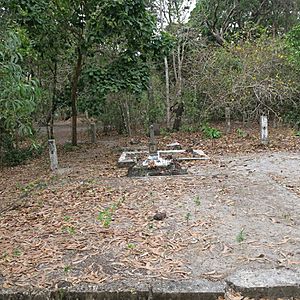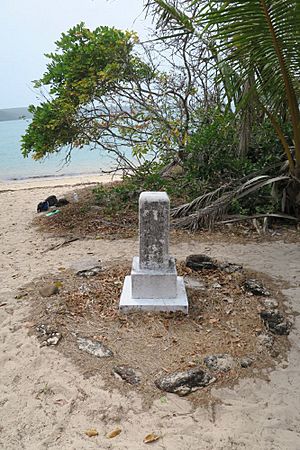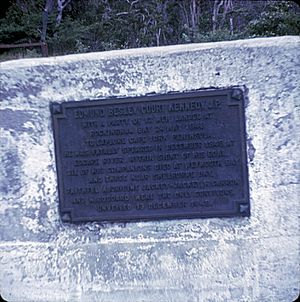Somerset Graves Site facts for kids
Quick facts for kids Somerset Graves Site |
|
|---|---|

Jardine Graves, facing south-east, 2017
|
|
| Location | Somerset, Northern Peninsula Area Region, Queensland, Australia |
| Official name: Somerset Graves Site; Somerset Jardine Cemetery | |
| Type | state heritage |
| Designated | 25 January 2018 |
| Reference no. | 650072 |
| Lua error in Module:Location_map at line 420: attempt to index field 'wikibase' (a nil value). | |
The Somerset Graves Site is a special cemetery in Somerset, Australia. It is located in the Northern Peninsula Area Region of Queensland. This site is also known as Somerset Jardine Cemetery. It was added to the Queensland Heritage Register on January 25, 2018. This means it is a very important historical place.
Contents
What is the Somerset Graves Site?
The Somerset Graves Site is about 2,379 square metres in size. It is on the northwest edge of Somerset Bay, Cape York. This site holds the graves of several people. These include Francis (Frank) Lascelles Jardine and three of his family members. There are also two pearl divers buried here. One grave is unidentified.
Why is Somerset important?
Somerset was started in 1864. It was a joint project between the Queensland and British governments. They wanted a safe port for ships to stop and refuel. This was important for ships travelling through the Torres Strait. The graves at the site date from 1890 to 1962. They help us understand the people who lived in Somerset. The site is also closely linked to the Jardine family. They were some of the first European settlers in Cape York.
The History of Somerset
After Queensland became a separate colony in 1859, it had a very long coastline. The government wanted a direct shipping route to England. They needed a port in the far north of Queensland. In 1861, Sir George Ferguson Bowen, the Governor of Queensland, said a northern station was needed. This was also important because France had started a colony in New Caledonia.
Choosing the Location
In 1862, Governor Bowen chose the site for the new settlement. It was across from Albany Island. He named it Somerset. This name honoured the First Lord of the Admiralty, Edward Seymour, 12th Duke of Somerset.
Buildings were planned in 1863. The town of Somerset was officially created in 1864. The area where the graves are located was part of the original town plan.
The Jardine Family's Role
John Jardine was Somerset's first Police Magistrate. He was also the Commissioner of Crown Lands. His sons, Frank and Alick Jardine, were famous explorers. In 1864-1865, they travelled overland from Rockhampton to Cape York. They brought the first cattle to the area. This helped supply fresh meat to Somerset. The Jardine River was named after them. They even won an award for their exploration.
Frank Jardine later became a Police Magistrate in Somerset. He married Sana Sofala, a woman from Samoa. They had four children. Frank Jardine lived in Somerset until he died in 1919. He continued to raise cattle and work in the pearling industry. He also helped travellers and sailors. For example, he helped survivors of the RMS Quetta shipwreck in 1890.
Changes in Somerset
Somerset became less important as a port. A safer shipping route was found. A new settlement was built on Thursday Island starting in 1876. Even though the port moved, Frank Jardine stayed in Somerset.
Indigenous People of Cape York
Many Indigenous groups lived in this area before Europeans arrived. In the 1870s, about 3,000 Indigenous people lived between Newcastle Bay and Cape York. By 1896, this number had fallen to about 300. This was due to new diseases and changes to their traditional lands. There was also conflict with the new settlers.
Graves at the Site
The Somerset Graves Site has two main areas: the north grave area and the south grave area.
North Grave Area
This area holds the graves of two pearl divers. The earliest known burial is Cancan, a pearl diver who died in 1890. His grave has a marble headstone. It says:
SACRED TO THE MEMORY OF CANCAN - ( A GOOD MAN AND TRUE ) - DIED JUNE 21. 1890 - AGED 32 YEARS.
Another grave belongs to Kobori Ichimatsu. He was a Japanese pearl diver who died in 1909. His grave has a concrete monument. The pearling industry was very important in the Torres Strait. Many Japanese divers worked there. The inscription on his grave is in Japanese. It says:
- Southern face: Kobori Ichimatsu's grave
- Eastern face: Died in the spring of Meiji Forty Two (1909)
- Western face: Built by Kobori Otomatsu from Nishi Mukai village, Wakayama prefecture
Kennedy Memorial Monument
Between the two grave areas is the Kennedy Memorial Monument. It was unveiled in 1948. This was 100 years after Edmund Kennedy's exploration of Cape York. The monument has a bronze plaque. It tells the story of Kennedy's journey. He was exploring Cape York Peninsula in 1848. He died near Escape River. Only three of his companions survived.
South Grave Area
This area contains the graves of Jardine family members. Frank Jardine was buried here in 1919. His wife, Sana, died in 1923 and was buried nearby. A memorial for them was put up in 1924. It has plaques dedicated to both Frank and Sana.
One grave in this area is believed to be for a child. It has a small, roughly carved stone marker. Another large grave is thought to be a family plot. It may hold Frank Jardine and Sana's mother.
Frank and Sana's grandson, Cholmondeley Gordon Vidgen, is also buried here. He died in 1962. His grave has an inscribed headstone. It says:
Dec. 1962. Here lies Gordon Vidgen. True son of the North. Always remembered by his wife and children.
Many of the graves are decorated with thick iron chains. These might be from old ships. Both grave areas are surrounded by white concrete posts.
Why is it a Heritage Site?
The Somerset Graves Site is important for several reasons. It helps us understand Queensland's history.
Demonstrating History
The site shows how the Queensland government tried to create a port in Cape York. Somerset was a key regional centre from 1864 to 1876. It was also a place where Europeans and Indigenous people met. The pearl divers' graves show the important and dangerous pearling industry. This industry used workers from many different backgrounds.
Potential for Knowledge
The site can teach us more about the people who lived in Somerset. We know there are seven marked graves and at least one unmarked one. There might be more burials here. Studying the site could reveal how people were buried. It could also show us more about the diverse community of Somerset.
Special Association
The Somerset Graves Site has a special link to the Jardine family. They were very important in the exploration and settlement of Cape York. John Jardine and his son Frank held important government jobs. Frank and Alick Jardine were famous explorers. They brought the first cattle to Cape York. The Jardine River is named after them.



